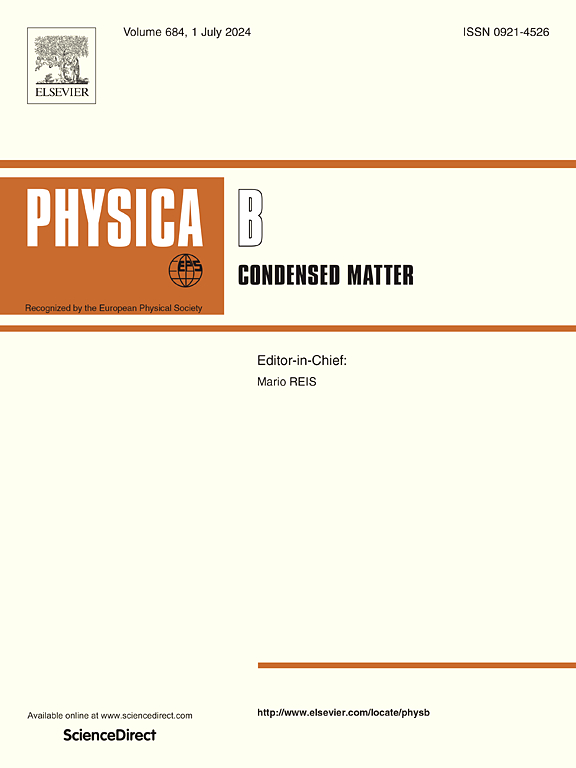评价混合vdW-DF2与rVV10和PBE官能团的交换相关性:展示对过渡金属二硫族化合物物理性质的影响
IF 2.8
3区 物理与天体物理
Q2 PHYSICS, CONDENSED MATTER
引用次数: 0
摘要
最近的研究主要集中在增强范德华相互作用的建模,特别是通过vdW- df方法。值得注意的是,vdW-DF技术的一些进步已经被引入,包括PBE+rVV10方法。这些方法旨在减少在特定材料范围内结合能和相互作用能分布的差异,以实现广泛的适用性。然而,这些模型在高能材料(如二维过渡金属二硫族化合物(2D-TMDCs))方面的有效性仍未得到检验。这些材料的独特特性,包括它们的直接带隙、高载流子迁移率、优异的稳定性和可用性,在当代研究中引起了极大的兴趣。在本研究中,密度泛函理论(DFT)应用于量子ESPRESSO框架,研究了混合范德华密度泛函(vdW-DF2)对rVV10和perdu - burke - ernzerhof (PBE)相关势的影响。我们的研究结果表明,vdW-DF2泛函的实现通过减轻与其他泛函相关的晶格参数的高估,显著影响了化合物MoX2(其中X = S, Se, Te)的特性。我们的结果表明,晶格参数a和c在不同的泛函中表现出变化。PBE函数对MoS2的预测值为a = 3.68 Å和c = 13.37 Å,而vdW-DF2函数预测值为a = 3.161 Å和c = 12.296 Å,两者的相对差值(da, dc)分别为0.032和0.049。在MoSe2中,PBE的结果为A = 3.31 Å和c = 13.00 Å,而vdW-DF2的结果为A = 3.293 Å和c = 12.918 Å,两者的相对差异分别为0.091和0.140。在MoTe2的情况下,PBE估计a = 3.87 Å和c = 13.91 Å,而vdW-DF2报告a = 3.551 Å和c = 13.817 Å,相对差异分别为0.881和1.095。在电子和弹性性能方面,我们证明了PBE功能与同类产品相比具有优越的性能。我们关于光学性质的发现为材料的光探测应用的适用性提供了见解。有趣的是,从PBE功能中得出的结果与现有的实验数据非常吻合。本文章由计算机程序翻译,如有差异,请以英文原文为准。

Evaluating the performance of the exchange correlation of the hybrid vdW-DF2, in comparison to rVV10 and PBE functionals: Showcasing the impact on the physical properties of transition metal dichalcogenides
Recent investigations have focused on enhancing the modeling of van der Waals (vdW) interactions, particularly through the vdW-DF method. Notably, several advancements in vdW-DF techniques have been introduced, including the PBE+rVV10 approach. These methodologies aim to reduce the discrepancies in binding energies and interaction energy profiles across a specific range of materials, with the intention of achieving broad applicability. However, the effectiveness of these models in relation to energetic materials, such as two-dimensional transition metal dichalcogenides (2D-TMDCs), remains unexamined. The distinctive characteristics of these materials, including their direct band gap, high carrier mobility, excellent stability, and availability, have garnered significant interest in contemporary research. In this study, density functional theory (DFT), as applied within the Quantum ESPRESSO framework, was employed to investigate the impact of the hybrid van der Waals density functional (vdW-DF2) in relation to the rVV10 and Perdew–Burke–Ernzerhof (PBE) correlation potentials. Our results reveal that the implementation of the vdW-DF2 functional significantly affects the characteristics of the compound MoX2 (where X = S, Se, Te) by alleviating the overestimation of lattice parameters associated with other functionals. Our results reveal that the lattice parameters a and c exhibit variation across different functionals. The PBE functional predicts values of a = 3.68 Å and c = 13.37 Å for MoS2, while the vdW-DF2 functional provides a = 3.161 Å and c = 12.296 Å, resulting in relative differences (da, dc) of 0.032 and 0.049, respectively. A similar pattern is noted for MoSe2 where PBE yields a = 3.31 Å and c = 13.00 Å, in contrast to vdW-DF2, which gives a = 3.293 Å and c = 12.918 Å, leading to relative differences of 0.091 and 0.140, respectively. In the case of MoTe2 PBE estimates a = 3.87 Å and c = 13.91 Å, while vdW-DF2 reports a = 3.551 Å and c = 13.817 Å, with relative differences of 0.881 and 1.095, respectively. In terms of electronic and elastic properties, we demonstrated that the PBE functional reveals superior performance compared to its counterparts. Our findings regarding optical properties provide insights into the material’s suitability for photodetection applications. Interestingly, the results derived from the PBE functional were found to align well with existing experimental data.
求助全文
通过发布文献求助,成功后即可免费获取论文全文。
去求助
来源期刊

Physica B-condensed Matter
物理-物理:凝聚态物理
CiteScore
4.90
自引率
7.10%
发文量
703
审稿时长
44 days
期刊介绍:
Physica B: Condensed Matter comprises all condensed matter and material physics that involve theoretical, computational and experimental work.
Papers should contain further developments and a proper discussion on the physics of experimental or theoretical results in one of the following areas:
-Magnetism
-Materials physics
-Nanostructures and nanomaterials
-Optics and optical materials
-Quantum materials
-Semiconductors
-Strongly correlated systems
-Superconductivity
-Surfaces and interfaces
 求助内容:
求助内容: 应助结果提醒方式:
应助结果提醒方式:


